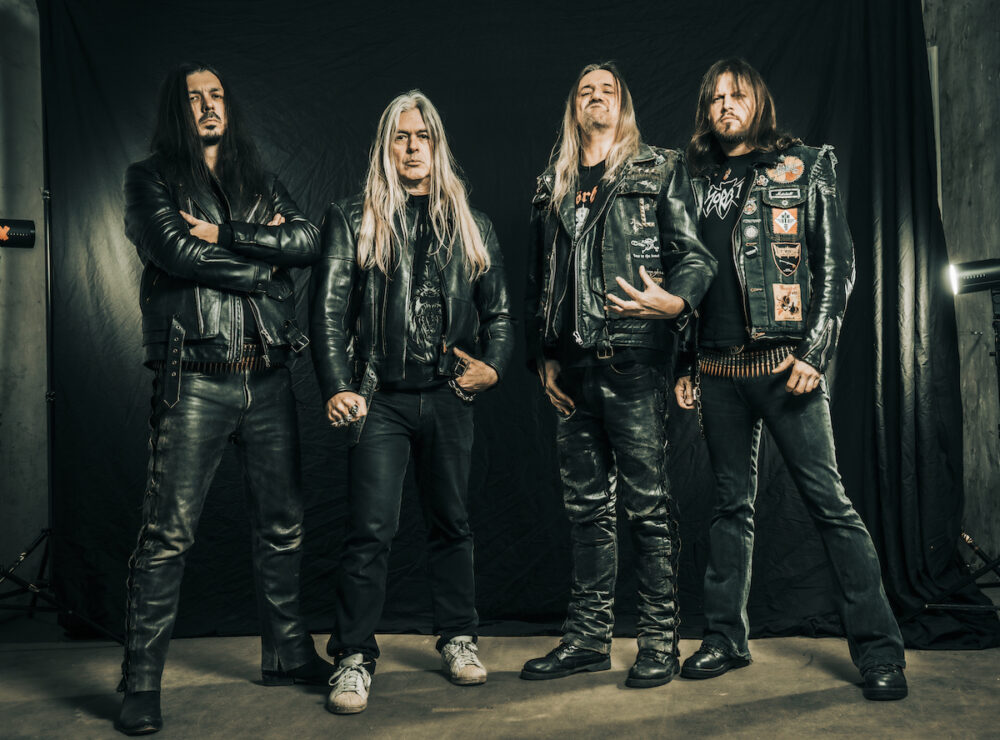Trigger Discipline: In Praise Of The Teutonic Thrash Titans

The godfathers of American thrash have had a rough go of it in the 21st century. The Big Four – that’s Metallica, Megadeth, Slayer, and Anthrax, if you’re new here – have released a cumulative 20 studio albums since 2000. What’s the best of those records? It certainly isn’t any of Metallica’s limp, post-St. Anger nostalgia trips. Megadeth buried a handful of great tunes on The World Needs A Hero and The System Has Failed, but they’re both too filler-heavy to recommend without reservation. Slayer’s God Hates Us All has its share of defenders, and I’ll at least entertain the idea that its nü-isms are successful on their own terms. Personally, I hear a band who was afraid of aging out of the arena circuit trying desperately to impress the Slipknot set. I think the answer might be Anthrax’s 2011 album Worship Music, which found them reuniting with their classic-era vocalist Joey Belladonna. When’s the last time you listened to Worship Music? Have you even heard it?
A few rungs down the popularity ladder, where the stakes are significantly lower, the story has gone a little better. Testament’s past four albums have all been solid, and with Alex Skolnick, Steve DiGiorgio, and Gene Hoglan playing on the last two, they also boast some of the finest playing in modern thrash. Exodus, Overkill, and Death Angel have managed a few modest successes between them. Deeper underground, there have been invigorating new albums by Morbid Saint, Blood Feast, and Sadus. (Unfortunately, the early returns on the Dark Angel reunion are truly dire: AI art, unimaginative riffs, neutered production, and career-worst vocals by Ron Rinehart, who was never a particularly strong point for the band.) Despite these few diamonds in the rough, the US’s claim to international thrash supremacy expired right around when Metallica cut their hair.
The inheritors of the thrash throne have undoubtedly been the Germans. Teutonic thrash, as it’s often called, lagged behind the Bay Area scene by a few years, but it quickly caught up. With a nominal Big Four of its own – Kreator, Sodom, Destruction, and Tankard – the Germans shared the Americans’ goals of playing faster, meaner, and eviler than their metal forebears. Sodom lapped the field on the last of those parameters, providing an early blueprint for black metal with early releases like In The Sign Of Evil and Obsessed By Cruelty. Kreator were the consummate professionals of the bunch, with the tightest playing and the sharpest songwriting. Destruction were the slightly cracked geniuses, with a knack for writing great riffs that somehow sounded wrong, like the openings of “Mad Butcher” and “Bestial Invasion.” Tankard, with their lyrical fixation on beer and jokey album art, were the scene’s resident goofballs — kind of a German Anthrax, albeit never quite as good as Anthrax were at their best. Germany had a deep bench, too, and I’m not talking about Mo Wagner backing up his brother Franz at the 2024 Olympics. Exumer, Holy Moses, Assassin, Minotaur, Torment, Poison, Protector, Necronomicon, and the eternal weirdos in Mekong Delta rounded out a scene that has still never fully gotten its due.
I’ll gladly put the Teutonic Big Four’s early classics up against anything that was coming out of California at the time. The German bands didn’t hit the same commercial heights as the Americans; they couldn’t, not with their warped riffs, jerky tempo shifts, and heavily accented vocals that were usually too shrieky to understand anyway. But they built something in the shadows that was less fickle than what was so rapidly mainstreamed and spat out again in the States. In 2025, four full decades removed from the debut albums by Kreator, Sodom, and Destruction, the Teutonic thrash scene is still steady as she goes. Sodom just released The Arsonist, an album that stands tall among the best work in their discography. In March, Destruction dropped the rock-solid Birth Of Malice, their thirteenth(!) studio album since 2000. Kreator are currently touring Europe and awaiting the theatrical release of a career-spanning documentary called Hate & Hope. Their 2022 album, the Arthur Rizk-produced Hate Über Alles, was another ass-beater in a long line of them. Tankard, because they can’t be anyone else, are still Tankard. Their last album was the pretty-fun Pavlov’s Dawgs. (It’s here that we say goodbye to Tankard for the remainder of this piece — enjoy a nice cold pilsner, gentlemen.)
To have any discussion about the German thrash scene’s pole position in 2025, you have to start in 2001. That was a generational year not just for Teutonic thrash, but for any regional metal scene that’s ever existed. In consecutive months in the fall of 2001, Destruction released The Antichrist, Kreator released Violent Revolution, and Sodom released M-16. We’ve been over the quality of the releases the American Big Four have been pumping out post-Y2K. Compare that to these three albums, all of which are stone-cold classics, all of which would sit within a fan-consensus top five in its band’s discography. Each is also an album-length encapsulation of how its makers transitioned into the 2000s, and an illustration of how they’ve stayed successful.
Just about every thrash band in the world endured a creative dip in the ’90s, but nobody fell further than Destruction did with 1998’s The Least Successful Human Cannonball. They’ve all but scrubbed it from their history, and with good reason—it’s butt rock. It’s not even good butt rock. Guitarist Mike Sifringer, soldiering on after the departure of founding frontman and bassist Schmier, took all the post-grunge, nü metal, industrial rock, and groove metal he was hearing on the radio and tried his best to Destruction-ize it. What he ended up with sounds like Pantera covering Audioslave, badly. Schmier returned for 2000’s All Hell Breaks Loose and the band hit their stride again, peaking the following year with The Antichrist.
In retrospect, The Antichrist signaled where Destruction were headed. The peculiarity of their early work was replaced with laser-precise, buttoned-up tightness, and their once-raw production style got supplanted by a clean, almost clinical sound. That’s still what they’re doing, with Schmier and a rotating cast of musicians. (Sifringer left the band in 2021.) The Antichrist, like the best albums in Destruction’s discography since then, excels purely on its songwriting and performances. “Thrash Till Death” and “Nailed To The Cross,” batting second and third on The Antichrist’s lineup card, are maybe the two biggest hits the band ever made, and rightly so. They’re expertly constructed modern thrash songs, played damn near perfectly. Destruction were never associated with perfection in the ’80s, but on The Antichrist and beyond, they’ve made it their calling card.
Kreator were also coming out of a brief ’90s doldrums when they made Violent Revolution, though I’ll freely admit that I have a soft spot for 1999’s poppy, goth-y Endorama. Even so, Revolution was a rebirth, emblemized by the addition of Sami Yli-Sirniö alongside founder and co-guitarist Mille Petrozza. What Kreator realized on Violent Revolution, and what they’ve been doubling down on ever since, is that their style lends itself especially well to huge, bright Gothenburg death metal melodies. Their six 21st century albums have been canny melodeath/thrash hybrids, blending hyper-speed riffs with sky-scraping lead work and Petrozza’s inimitably gruff vocals. My favorite neo-Kreator album is 2005’s Enemy Of God, which opens with the earthshaking title track and never lets up, but they’re uniformly excellent. When I saw Kreator live last summer, they played a handful of ’80s tunes, but there was much more post-2000 music in the setlist. They might be the only thrash band who can get away with that.
Sodom also released a career highlight in 2001 with M-16, but they hadn’t really fallen off in the ’90s. In fact, they were coming off another career highlight, 1999’s Code Red. Its follow-up saw the same crack lineup return: bassist/vocalist and sole constant member Tom Angelripper, drummer Bobby Schottkowski, and guitarist Bernd Kost. Consistency has defined the band’s enduring greatness, and while M-16 might seem at first blush like just another quality Sodom album, it’s the most successful they’ve ever been at conjuring and controlling an atmosphere. Sodom albums are mostly about war, but they’re not usually all about war. M-16 traps us in a sweat-choked barracks at the peak of the Vietnam War and never lets us out. It’s Sodom’s only concept album, and they make sure that narrative focus doesn’t go to waste. Sampling Apocalypse Now on “Napalm In The Morning” is a well-earned flex — M-16 is the only metal album I’ve ever heard that approximates the jungle hell of Coppola’s film.
War has remained central to the Sodom albums that have come out since M-16. They’re all broadly anti-war in that uniquely metal way — the “war is hell, but the imagery sure is cool” approach that started with “War Pigs” and will continue long after we’re all dead, maybe in some heretofore unwaged war. Kreator’s explicitly antifascist politics are more coherent, but Sodom play their war songs with a martial intensity that can’t be faked. On The Arsonist, the best Sodom album since M-16, Angelripper revisits Vietnam (“Battle Of Harvest Moon), inhabits a sharpshooter suffering a psychotic break (“Trigger Discipline”), and laments the inevitability of a soldier’s death, either on the battlefield or after it, by suicide (“Return To God In Parts”). He paraphrases Wilfred Owen’s “Anthem For Doomed Youth,” and the trenches come alive: “Rifle’s rapid rattle/ No prayers and no bells, no tenderness of patient minds/ Ghosts of glowing shells.”
Perhaps the biggest key to The Arsonist’s success is the presence of guitarist Frank Blackfire, who played on Persecution Mania and Agent Orange back in the ’80s and rejoined Sodom in 2018. (Blackfire also played on Kreator’s Coma Of Souls, the best album the Teutonic scene ever produced. Dude’s no slouch.) He and co-guitarist Yorck Segatz, who also joined the band in 2018, excel at playing blitzkrieg thrash riffs, duh. But they also sound great in the moments when things slow down a bit, and dark, haunted melodies worm their way into the songs. It’s hard to say what the all-time best Sodom lineup is, but every time Angelripper and Blackfire have played on an album together, it’s been magic.
While the Teutonic titans continue firing at will, the next generation of thrashers is ensuring that their legacies are secure. Warfield, a young band led by two brothers from southwestern Germany, sounds like classic Sodom on speed and cheap beer. Sweden’s Sarcator named their band partly after Kreator, and they’ve already put out three taut, ambitious, big-tent thrash albums, all before frontman Mateo Tervonen’s 20th birthday. Wise Blood Records’ essential Faster Than The Devil compilation series has highlighted 15 rising thrash bands since 2022, and not one of them sounds more like Megadeth than Destruction. Teutonic thrash feels like it’s finally enjoying a long-overdue cultural moment. Next year’s edition of Maryland Death Fest, America’s biggest and longest-running metal festival, boasts both Kreator and Destruction as headliners, and I just saw Sodom headline the Hell’s Heroes fest in Houston last year. This doesn’t happen often, so enjoy it — a music scene’s steadfastness and refusal to compromise is being rewarded.
TEN NAILS THROUGH THE NECK
Judas Priest – "War Pigs" (Black Sabbath Cover)
Location: Birmingham, England
Subgenre: heavy metal
I almost threw out this entire column and turned it into an obituary for Ozzy Osbourne. How could I not? We lost one of heavy metal’s cofounders on July 22, just a couple of weeks after Back To The Beginning, the farewell concert he played with Black Sabbath in the band’s hometown of Birmingham, England. I didn’t know the man – I did have to privilege of talking to him once, for this website – but like all incredibly famous people, I felt that I knew him. In the many remembrances that have been popping up on social media, a recurring theme has been the idea of Black Sabbath as something ubiquitous, immutable, natural; a constant like the water or the air. That feels right. I certainly don’t remember the first time I heard Black Sabbath. My dad was and remains a classic-rock radio devotee, so for all I know, I heard “Iron Man” on my way home from the hospital the day after I was born. I do know that the first album I bought was Paranoid, when I was 12 years old, and that I quickly filled in the gaps in the Sabbath and solo Ozzy discographies. My taste in metal shot out in a hundred different directions in the heady months that followed, but I never lost sight of the fact that Sabbath was the bedrock, the foundation on which everything else was built. Yet you never listen to those early Sabbath albums and think of them as a rough draft. It’s all there, carved from raw marble by four working-class Brummie teens, led by a singer whom no one has ever managed to credibly rip off.
When I hear Judas Priest’s recent take on “War Pigs,” I think about the timelessness of what Ozzy, Tony Iommi, Geezer Butler, and Bill Ward created. Priest were also from Birmingham, another group of longhaired, working-class kids who wanted to push rock music to new extremes. If Sabbath invented heavy metal, it was Priest who refined it, turned it into an identifiable sound and aesthetic. Rob Halford was a more conventionally talented vocalist, with a much bigger range, but I’ve always been struck by how much he looked up to Ozzy. He could sing circles around him, but he never thought he was better, and on this recording of “War Pigs,” Halford’s virtuosity never outshines Ozzy’s personality. It’s the most beautiful tribute I can imagine from one friend to another who was preparing to cross the veil. Halford and Ian Hill, Priest’s bassist, were teenagers when “War Pigs” came out. The rest of the guys who play on the cover were either not born yet, or were still little kids, blissfully unaware of the rock revolution coming down out of the Midlands. They’re a part of it now. Heavy metal is an endless thread that runs from Sabbath’s discovery in 1970, through all the bands that never could have existed without them, to an eternity in which no one will ever remember life without Ozzy Osbourne’s music. Oh lord, yeah. [Single out now via Black Sabbath’s YouTube channel.]
Stangarigel – "Kde Kladivá Obrov Rozmetali Hory"
Location: Bratislava, Slovakia
Subgenre: black metal
The premier underground metal band of the past decade might be Malokarpatan, the cult-beloved Slovakians whose four albums showcase a frequently bonkers blend of the European continent’s quirkiest proto-black metal. By comparison, Malokarpatan guitarist Adam Sičák’s Stangarigel is a more straightforward affair. Across two albums and an EP, the duo of Sičák and drummer/vocalist Stalagnat has sought to revive the strain of ’90s black metal that hinted at the eventual development of the folk metal subgenre. Za Striebornou Horou isn’t a folk metal album, but it does carry a certain pagan air about it, and in the forest of driving rhythms and eerie riffs, traditional instrumentation sometimes pokes its head out from behind a tree. The mouth harp that stalks the middle section of “Kde Kladivá Obrov Rozmetali Hory” is an invitation to sit down by the fire and watch all the witches dance. [From Za Striebornou Horou, out now via Medieval Prophecy Records.]
Re-Buried – "Putridity In Existence"
Location: Seattle, Washington
Subgenre: death metal
The longest and slowest song on Re-Buried’s Flesh Mourning is “Putridity In Existence,” which appears near the end of the album and finally consummates the Seattle band’s Autopsy-style flirtations with doom. Though the tempo does eventually pick up, the song is all about those plodding first couple of riffs, and the way they’re paired to Chris Pinto’s deeply gnarly vocal dry heaves. Re-Buried are among the more convincing old-school death metal revivalists in the U.S. right now, and on “Putridity In Existence,” it sounds like they’ve just discovered their cheat code. [From Flesh Mourning, out now via Translation Loss Records.]
Vulning – "The Altar"
Location: Columbus, Ohio
Subgenre: progressive metal
I still don’t have my head around Vulning’s debut album, The Wound. I’m giving it an incomplete for now; feel free to check in with me at the end of the year. It’s not just that it throws a lot at you, though it certainly does that — with seven songs in 66 minutes, it’s giving CD-era prog metal. It’s not even the gamut of influences, which on closing track “The Altar” alone seems to include Agalloch, Isis, Tool, Devin Townsend, At The Drive-In, Deafheaven, Thursday, and probably some other screamo-adjacent bands who I can’t identify because I don’t usually party like that. I think it’s the way the slipperiness of the whole thing defies its cohesion. There’s a sense that Vulning can turn any corner at any time, all while continuing to hammer the central emotion of the song. That makes The Wound exciting, even if I’m still not quite sure what I make of it. [From The Wound, out now via the band.]
Witchyre – "The Spirits Robbed My Mind"
Location: Neumarkt in der Oberpfalz, Germany
Subgenre: black metal/dungeon synth
I’m going to make the unconventional recommendation that you don’t start listening to Witchyre’s Witchy Forest Dance Contest from track one. That song, “Let There Be Light…,” is excellent, but it gives too much of the band’s game away up front. Start instead with track two, “The Spirits Robbed My Mind.” For three minutes, you’ll be swept up in a maelstrom of raw black metal fury, with subtle strains of dungeon synth bobbing below the waves. Then you’ll hear the Eurodance part. Go back to “Let There Be Light…” It’s mostly Eurodance parts. Take a break to listen to Darude’s “Sandstorm,” just to scratch the itch. Then finish Witchy Forest Dance Contest and let me know if you can figure out how Witchyre smuggled an early Dance Dance Revolution soundtrack into a very good black metal album. [From Witchy Forest Dance Contest, out now via Grime Stone Records.]
Cronos Compulsion – "Obligate Condition"
Location: Denver, Colorado
Subgenre: death metal
Cronos Compulsion are not fucking around for even one second of Lawgiver, their 24-minute debut album. The Denver band wants to cut your head off, and their songs are engineered to do that as efficiently as possible while inflicting maximum bloodshed. You know “Blissful Bloodshower,” the 51-second song on Incantation’s Mortal Throne Of Nazarene? Lawgiver is like a full album of “Blissful Bloodshower”s, none more reverent to the blueprint than opening track “Obligate Condition.” Evil, doomy, dissonant death metal doesn’t have to be overly complex or clever to administer Incantation-level pain. Cronos Compulsion dispense with the bullshit and bring you the blade. [From Lawgiver, out now via Unorthodox Emanations]
Floating – "I Reached The Mew"
Location: Uppsala, Sweden
Subgenre: progressive death metal/post-punk
For nearly as long as there’s been death metal, there have been bands reaching outside its hermetic walls to augment and enliven it. In that sense, the young Swedes in Floating are the scions of a storied tradition, one that starts at the dawn of the genre, with Chuck Schuldiner. Their small innovation, of wedding the eccentric prog-death of Gorguts and Demilich to the gleaming, goth-y post-punk of the Cure, Joy Division, and Siouxsie And The Banshees, still feels thrillingly new. (Apologies to Katatonia’s road-not-taken EP, Saw You Drown, which comes close but mostly lacks the death metal element.) “I Reached The Mew,” which may or may not be about tracking down the 151st Pokémon, is the peak of the form they’re pioneering. The bright, springy lead bass and flangered guitar feel like they were beamed here from another song and, with no choice but to adapt, figured out how to play death metal on the fly. It’s cool as hell. [From Hesitating Lights, out now via Transcending Obscurity Records.]
Sepulchre – "Hail As Gods"
Location: Nashville, Tennessee
Subgenre: black metal
One of the most out-of-nowhere debuts of the year (for me) comes from Sepulchre, a band with no record label, no digital footprint, and no publicly known members. I don’t know how I found it, but I’m glad I did: Psalms Unto Caesar is a black metal masterclass, inspired by most of the usual ’90s suspects but with an uncommonly forthright sense of melody and some excellent keyboard work. “Hail As Gods” is the stunning mid-album pillar, and the lush synths and plinking piano lines that encircle the drums and guitar here remind me a lot of Summoning, a band I wish more artists would borrow from. Hail Sepulchre! [From Psalms Unto Caesar, out now via the band.]
Weald & Woe – "Radiant One"
Location: Boise, Idaho / Portland, Maine
Subgenre: melodic black metal
You don’t tend to get a lot of love songs in black metal, unless they’re about, like, wanting to bathe in blood with Elizabeth Bathory. That makes “castle metal” stalwarts Weald & Woe’s “Radiant One” a pleasant surprise. Sung from the perspective of a knight who’s lost his maiden, the pseudo-ballad aches with a vulnerability – a softness, even – that’s rare for the genre: “I have known the freedom of love/ Felt the sting of the blade on my skin … I’m unsure which pain hurt worse.” Those words snake through the spaces between the bright, melodic guitar lines of Jeff Young and Brent Ruddy, while session drummer Ryan Sparrell’s blasting keeps “Radiant One” rooted in black metal’s inherent aggressiveness. Weald & Woe are best known for their obsession with medieval themes and imagery, but the emotion of this song cuts straight through its aesthetic trappings. The best suit of armor is no match for a broken heart. [From Far From The Light Of Heaven, out now via Fiadh Productions.]
Fili Bibiano's Fortress – "Night City"
Location: Whittier, California
Subgenre: heavy metal
That endless thread of heavy metal that I talked about in the “War Pigs” blurb has led us here, to 2025’s Metal Song Of The Summer. Let me talk about a few of the things I love about “Night City,” the new standalone single by Fili Bibiano’s Fortress. First, it’s by a band called Fili Bibiano’s Fortress. Bibiano is the guitarist for Fortress, not the lead singer, which means Fili Bibiano’s Fortress is almost certainly tipping its cap to Yngwie J. Malmsteen’s Rising Force. That was the name of the Swedish shred god’s band for his first four albums, including 1986’s Trilogy, with vocalist Mark Boals. Fortress singer Juan Aguila sounds a little like Boals, and “Night City” takes a few cues from the Trilogy hit “You Don’t Remember, I’ll Never Forget.” That’s sick.
The other song that “Night City” reminds me of is a Black Sabbath tune, albeit one that only the dorkiest of metalheads are likely to be familiar with. “Headless Cross,” the title track of Sabbath’s 1989 album with Tony Martin on vocals, has its fingerprints all over “Night City.” (Martin is another singer that I think Aguila sounds like, but the way he blends his influences is all his own. Did I mention that “Night City” is the first publicly released song he’s ever sung on?) Bibiano’s guitar work on the song clears up why it’s his name on the record sleeve. The guy is a monster, whether he’s playing the restrained, classicist verse riffs or letting it rip with a colorful solo. He’s a little Iommi, a little Malmsteen, a little John Sykes, a little George Lynch, and all Bibiano. I also love his playing with bilingual hard rockers Intranced, but Fortress feels even more like his baby. There won’t be a new Fortress album until next year, but they dropped “Night City” at the perfect time. In the world of Breaking The Oath, at least, it’s the Song of the Summer. [Single out now via the band.]



